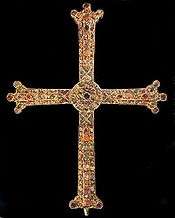Victory Cross
|
Picture of the Santa Cruz de la Victoria. | |
| Material | Various (incl. gold, gems). |
|---|---|
| Created |
Early Middle Ages (908 CE) |
| Present location | Cámara Santa, Cathedral of San Salvador of Oviedo |
The Victory Cross (Asturian and Spanish: Cruz de la Victoria) is an early 10th century Asturian Christian ornamented processional cross, which was, as an inscription says, made in 908 in the Castle of Gauzón (Raices Viejo, Castrillon, Asturias, Spain). It is a crux gemmata or jewelled cross, given by King Alfonso III of Asturias, who reigned from 848 to 910, to Cathedral of San Salvador of Oviedo (Asturias, Spain). According to the legend, the wooden core was carried by King Pelagius of Asturias at the Battle of Covadonga. The old oak wooden cross was covered with gold and precious stones in 908, under King Alfonso III and donated to the dean of the Cathedral of San Salvador (Oviedo), where is still today. However, there is no historical evidence that Pelayo used exactly this same cross.
Since December 1990, the flag of modern Principality of Asturias bears the Victory Cross offset towards the hoist.[1]
History
Tradition says that the primitive, undecorated wooden core of this cross was carried against the Muslims of al-Andalus by King Pelagius of Asturias at the Battle of Covadonga. But this is a legend, there is no historical evidence that Pelayo used exactly this same cross. Tradition continuous saying that the cross would later be kept by his son Favila of Asturias in the Church of Santa Cruz de Cangas de Onís erected by Favila and his wife Froiluba in 737 and dedicated to True Cross in Cangas de Onís, the first capital of the Kingdom of Asturias. The ornate casing, similar to that upon the Cross of the Angels, was added later, always according to tradition. However studies based on radiocarbon dating tests have demonstrated that the wooden core is contemporary to the ornate casing. [2]
The ornate casing contains 152 gems and imitation gems. An inscription tells us that this casing was made at the Castle of Gauzón in Asturias in 908. Alfonso III donated this important Pre-Romanesque gold artifact to Cathedral of Oviedo to commemorate a hundred years of the Asturian kingdom's victories and conquests.[3]
During the Spanish Civil War, the Cross, like the rest of the artifacts in the Cámara Sancta, suffered serious damages which required its restoration.[4]
The Victoria Cross recovered its gems from 1942 on, thanks to popular donations for the acquisition and restoration of the relic. However, the work of goldsmiths Horacio Rivero Alvarez and Luis Aguilar did not consider the original design, altering the position of the medallion on both fronts.[5] In 1971 new enamels were placed by German goldsmith Werner Henneberger, but here again the original design was not taken sufficiently into account.
On August 9, 1977, the Cross, together with Agate box and the Cross of the Angels, were stolen and suffered serious damage after the thieves torn their precious stones and gold plating. Its current appearance is the result of careful reconstruction carried out in 1978.
Description
The Latin cross is 92 by 72 centimetres (36 in × 28 in). The core is made of two 2.5 centimetres (0.98 in) thick pieces of oak with circular ends finished in three foils, and joined in the centre by a circular disk. The whole cross is covered with gold leaf and filigree, and richly decorated especially the anverse, covered with coloured enamel, pearls, precious stones and gold thread. The reverse shows an inscription in soldered gold letters, mentioning the donors to the Church of San Salvador, King Alfonso II and Queen Jimena, and the place (Gauzón Castle) and the year it was made:[3]
| “ | Svsceptvm Placide Maneat Hoc In Honore Di Qvod Offervnt Famvli Xpi Adefonsvs Princes Et Scemena Regina Qvisqvis Avferre Hoc Donaria Nostra Presvmserit Fvlmine Divino Intereat Ipse Hoc Opvs Perfectvm Et Concessvm Est Santo Salvatori Ovetense Sedis Hoc Signo Tvetvr Pivs Hos Signo Vincitvr Inimicvs Et Operatvm Es In Castello Gavzon Anno Regni Nsi XLII Discvrrente Era DCCCCXLVI A |
” |
Gallery
- Display of the Cross in the Cámara Santa of Oviedo.
 The coat of arms of Asturias is the official heraldic emblem of the Principality of Asturias. It was adopted as such on 27 April 1984.
The coat of arms of Asturias is the official heraldic emblem of the Principality of Asturias. It was adopted as such on 27 April 1984. 2D model of the cross.
2D model of the cross.
Notes
- ↑ Bandera del Principado de Asturias - Ley 4/1990, de 19 de diciembre (BOPAP nº 6, de 9 de enero de 1991. BOE nº 32, de 6 de febrero de 1991) (PDF) (in Spanish), 1990
- ↑ Dudas sobre la Cruz de la Victoria (in Spanish)
- 1 2 Williams 1907, p. 4
- ↑ See historic picture on Flickr http://www.flickr.com/photos/dinocefalo/3261696810/
- ↑ Official website of the Ayuntamiento of Oviedo
References
- Williams, Leonard (1907), Gold, silver, and jewel work. Iron-work. Bronzes. Arms, The arts and crafts of older Spain., 3, London: T.N. Foulis, pp. 40–41, OCLC 732659
- Schlunk, Helmut (1985). Las cruces de Oviedo : el culto de la vera cruz en el reino asturiano (in Spanish). Oviedo: Instituto de Estudios Asturianos (Oviedo, Spain). ISBN 84-505-1324-3. OCLC 20256995.
- González, García; Vicente, José (1979). La Cámara Santa y su tesoro (in Spanish). Oviedo: Principado de Asturias. ISBN 84-300-1192-7.
- Universidad de Oviedo (2002). La restauración de las joyas históricas de la Cámara Santa de Oviedo : 1977-1997 (in Spanish). Oviedo: Alvízoras. ISBN 84-86889-92-8. OCLC 166521733.
External links
| Wikimedia Commons has media related to Cruz de la Victoria - Asturias. |
